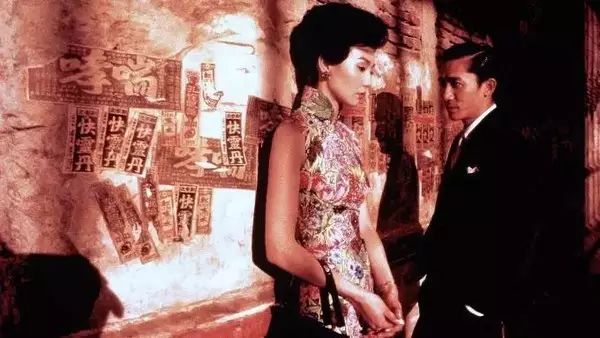In the Mood for Love, DIR. Wong Kar-wai (2000)
Pottinger Street, Central District, Hong Kong

Zhou Mo-wan (played by Tony Leung Chiu-wai) and Su Lizhen (played by Maggie Cheung) are chatting in Pottinger Street.
In the Mood for Love(1), directed by Wong Kar-wai and starring Tony Leung Chiu-wai and Maggie Cheung, was first released in Hong Kong, China on September 29, 2000. Set in Hong Kong in the 1960s, the film depicts an expressive romantic story of Su Lizhen and Zhou Mo-wan, who gradually fall in love with each other after being betrayed by their spouses. In that special period, the situation in Hong Kong was not that calm. It seems that not only the outer situation brought instability to Hong Kong but also brought numerous turbulences to every small family and this is why these two fates twist. In this film, Pottinger Street just acts as a spectator who witnesses this love story. They wander, chat and breathe together in this very moment in this street. As a consequence, Pottinger Street naturally becomes a concealed clue to the film.
Pottinger Street is connected to the hill of Hollywood Road and the hill under the Connaught Road. The street is covered with stones and designed into a concave-convex style, which is convenient for both pedestrian walking and rain falling along the sides of the street. Thus, people used to call it “stone street”. The Hong Kong government named it Pottinger Street in 1858 in honour of the first governor of Hong Kong, Henry Pottinger. Therefore, Pottinger Street has a long history and fully equipped with characteristics of the old era, old Hong Kong. That is also the reason why director Wong eventually chose this place to be the stage. In the film, viewers can deeply feel the classical and ambivalent atmosphere intentionally arranged by the director. The dim light, the mottled stoned wall, messy advertisements and the narrow passage all indicate the ambiguous love confined by morality between the main characters. Nevertheless, nowadays, although Pottinger Street still exists, there are quite a few differences compared to the film. Visitors can barely see the original appearance there, merely the stoned surface.
De Certeau (1984) once wrote in his book The Practice of Everyday Life that “A place (lieu) is the order (of whatever kind) in accord with elements are distributed in relationships of coexistence”(p117)(2). To sum up, a “place” is something with special emotions and meanings, an indication of stability. In this film, Pottinger Street exactly fits this concept and plays a significant role in connecting plots and conveying implies. The veiled affection in this film is perfectly expressed by the scene.
Pottinger Street also presents in several Hong Kong films, such as Chungking Express, another romantic film directed by Wong Kar-wai. Why this place is that popular in the film industry largely due to the old Hong Kong style it contains and the suggestive scene it shows. When people walk through it, they can hardly not think of romance and other hidden emotions. These elements all offer Pottinger Street extraordinary magical charm.
— HU Yujie, 3035771256
(p.s. Sorry, professor. I cannot upload the images due to some unknown technical problems. I have already sent them to your email. Thank you!)
Notes:
(1) In 2001, the film won the French Cesar Award for Best Foreign Language Film. In 2009, the film was selected as the first “Best Asian Film” by CNN. In September 2019, the film was ranked 5th among the “100 best films of the 21st century” by the British newspaper The Guardian. On February 19, 2020 – A 4K restored version of the film was released and had its world premiere at the 73rd Cannes International Film Festival in the “Cannes Classics” section to commemorate the 20th anniversary of the release of In the Mood for Love.
(2) De Certeau, M. (1984). The Practice of Everyday Life, translated by Steven Randall. Berkeley: University of California Press.
You have analyzed the atmosphere of Pottinger Street in the film well and tried to link its appearance to the theme of the story. Discussing it as a place with special emotions is appropriate as well. It would be interesting if you can add more comparisons between the site in reality now and that in the film. Then you will be able to spot how the director deployed and represented the space.